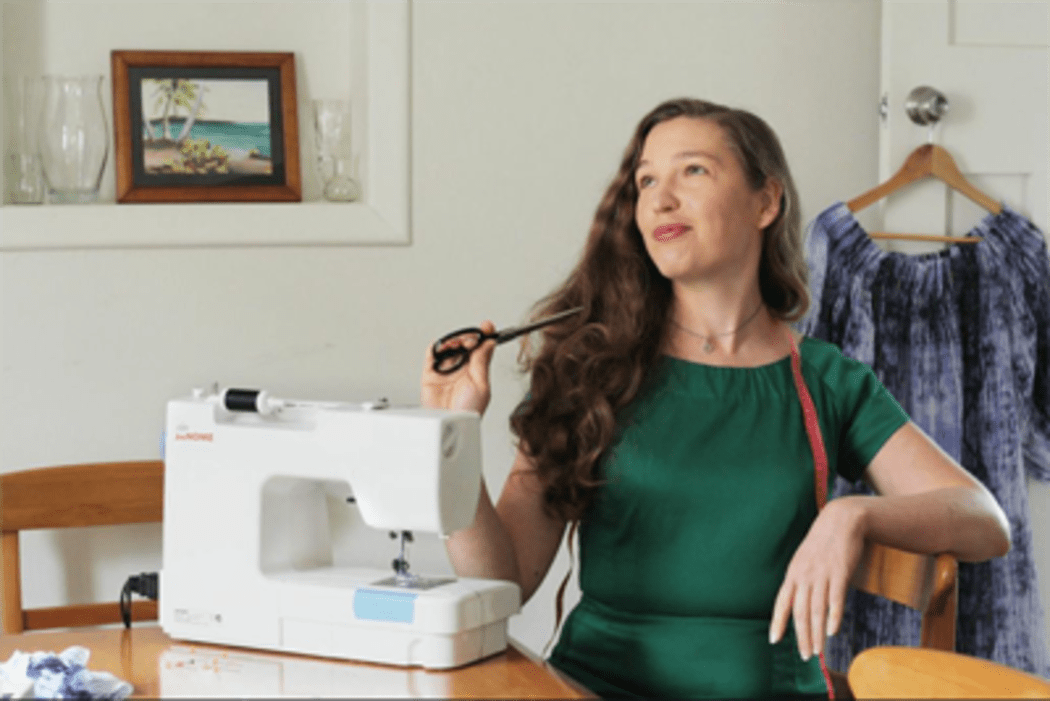Wellington-based costumier and clothing and textile historian Leimomi Oakes is the curator of a recently opened exhibition at the Katherine Mansfield Birthplace in Te Whanganui-a-Tara looking at the fashion of 19th century Wellington.
It's titled Meet the Making and it is part of the Threads Textiles Festival across the Wellington region and is on until June.
Oakes also takes people on journeys through how these clothes were made and keeps the techniques alive on her blog The Dreamstress.

Photo: Leimomi Oakes
The signature items on show include a range of undergarments, a petticoat, corset covers, accessories like bags and stockings, full outfits, and 1880s dress, from when Mansfield was born, that was refashioned in 1910 and again in the ‘20s or ‘30s.
Undergarments represent quite a high portion in the exhibition to illustrate the quick pace at which they changed in that period, Oakes says.
“When you go back the 19th century, women would actually get married and part of their wedding trousseau would be all the undergarments they were expected to wear throughout their entire life.
“They didn’t survive as much because they got worn and worn and worn.
“Then we head into Mansfield life in the 20th century, and women early in the 1900 to 1910, they are wearing these full-length very ruffled elaborate petticoats and then those petticoats become completely obsolete in the ‘20s, and so many undergarments survived because they became unwearable, because they didn’t work with the fashion at all.”
The fashion of those days may seem to be torturous to us now, but Oakes notes that the clothing that has been persevered through the years tends to be for special occasions.
“So, when we see older clothes, we tend to see the most formal, the least comfortable clothes.”
And from personal experience, Oakes knows it depends on how you wore those clothes and what you choose from the extensive range of fashion back then.
“As a fashion historian, one of the things I’ve done is spend two weeks dressing like it was 1916 and wearing all the clothes and living the lifestyle and doing the chores and the cooking as accurately as possible and what I found is actually they’re pretty comfortable clothes to wear.
“Corsets do not work with modern furniture but as long as you stick to straight back chairs, they’re not that uncomfortable and they’re great back support when you’re doing things like laundry in an old-fashioned way.
“Then of course, there’s always thinking about social structures in that the people who did the least work would wear the most elaborate, least comfortable clothing and then anyone who was doing any actual labour would wear a much more modified version of that garment that was easier to move in.”
One of Oakes’ favourite items at the exhibition is the petticoat with a clever 'invention'.
“This particular petticoat has a large pocket and I read some writings about pockets and they talk about how you could use them to store money but of course it was very cumbersome because how do you get it?
“But then I found some instructions from World War One, which tell women to store their sanitary products in their petticoat pockets. Sanitary pads had just become available in the early 1900s and were becoming popular in the 1910s.”
Mansfield herself was very interested in clothing and that comes through in her descriptions of characters.
“Her brother-in-law, Richard Middleton Murray, describes her as a head-turner – ‘the mode from Paris, the brown velvet jacket with silver buttons, the short skirts, the coloured stockings, the Spanish-Japanese hairdo, the high heels, the immaculate turnout’,” Oakes says.
“But on the other hand, the first time Virginia Woolf met her she was a little shocked by her commonness at first sight - ‘lines so hard and cheap’.
“So here we have a man who very much approves of how she dresses and a woman who thinks her outfit is terribly tacky.”

